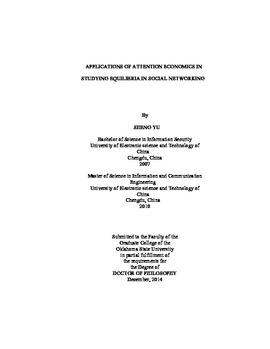| dc.contributor.advisor | Kak, Subhash C. | |
| dc.contributor.author | Yu, Sheng | |
| dc.date.accessioned | 2016-01-20T15:45:12Z | |
| dc.date.available | 2016-01-20T15:45:12Z | |
| dc.date.issued | 2014-12 | |
| dc.identifier.uri | https://hdl.handle.net/11244/25740 | |
| dc.description.abstract | Within social networking services, users construct their personal social networks by creating asymmetric or symmetric social links. They usually follow friends and selected professional users, such as celebrities and news agencies. On such platforms, attentions are used as currency to consume the information. The economic theory that deals with this situation of excessive information and scarce attention is called attention economics and it parallels standard economic theory although there are some interesting points of difference. In this dissertation, we use attention economic method to analyze interactions on social media. We statically and dynamically analyze a huge social graph with a manually classified set of professional users. The results show that the in-degree of professional users does not fit to power-law distribution. Conversely, the maximum number of professional users in one category for each user shows power-law property. We analyze the reasons of these phenomena wherein we consider questions of supply and demand, the game among professional users, the game among common and professional users, and the marginal utility of common users. The result of supply and demand determines the proportion of professional users in different subjects and the games strongly influence the profession users' interaction patterns. The marginal utility is the direct reason for users to follow and unfollow others. Finally, game theory from economics is applied to analyze the malicious URL attack on social media. Unlike other cyberspace, it is hard to directly publish malware or phishing page on social media. The attackers publish some bad-content URLs on social media, and lure users to click them with the URLs leading the users to the malicious page. These malicious URLs become the major gateway to further cyber-attacks on these platforms. We have shown that even with perfect and real-time detection algorithms, malicious URLs can easily snag many visitors, if they are checked by the system only once. We propose some countermeasures. Our research on the use of attention economics has demonstrated its significance for the study of social networks. | |
| dc.format | application/pdf | |
| dc.language | en_US | |
| dc.rights | Copyright is held by the author who has granted the Oklahoma State University Library the non-exclusive right to share this material in its institutional repository. Contact Digital Library Services at lib-dls@okstate.edu or 405-744-9161 for the permission policy on the use, reproduction or distribution of this material. | |
| dc.title | Applications of attention economics in studying equilibria in social networking | |
| dc.contributor.committeeMember | Crick, Christopher John | |
| dc.contributor.committeeMember | Chan-Tin, Eric David | |
| dc.contributor.committeeMember | Sheng, Weihua | |
| osu.filename | Yu_okstate_0664D_13694.pdf | |
| osu.accesstype | Open Access | |
| dc.type.genre | Dissertation | |
| dc.type.material | Text | |
| thesis.degree.discipline | Computer Science | |
| thesis.degree.grantor | Oklahoma State University | |
